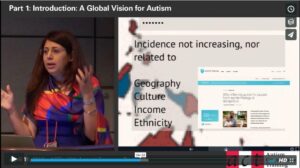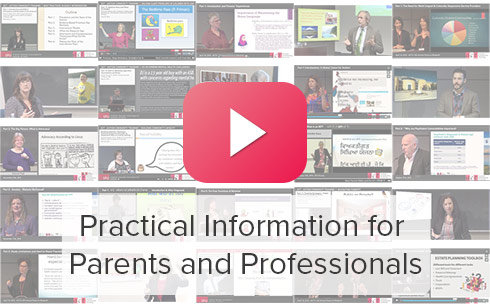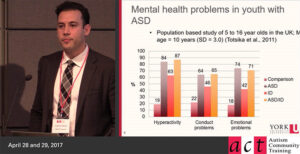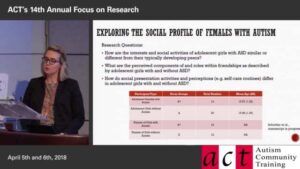
Richard Stock, PhD, BCBA-D
Filmed December 2020 over two days – edited into 25 parts; total 433 minutes
Download the presentation handout (56 Pages)
Educators and parents have long recognized that a well-developed Individualized Education Plan (IEP) is essential to ensure quality educational programs for diverse learners. In this video, Dr. Richard Stock demonstrates that a well-developed IEP, which includes input from educators, therapists and the family, is crucial to the effective support of students with autism and related neurodevelopmental conditions. This presentation is also broadly relevant to all families and professionals looking to understand how to improve the IEP process, regardless of diagnosis.
Dr. Stock considers IEP design and implementation with case examples from kindergarten through high school. Topics include correcting misconceptions about the role of IEPs and the importance of building collaborative teams.
While educators gave the live presentation top marks, the primary goal of this presentation is to give parents an understanding of the IEP process from A to Z, including:
- Assessing “present level” and developing meaningful goals.
- Selecting effective instructional methods.
- Accountability: measurement of student achievement and IEP effectiveness.
Supplemental Resources
Presenter Bio
Richard Stock, PhD, BCBA-D is one of B.C.’s most respected Behavior Analysts. He is highly regarded both as a teacher and a collaborative member of inter-disciplinary intervention teams.
Dr. Stock has been on faculty in the ABA – Autism Department at Capilano University since 2009 and coordinator of the program since 2013. He has extensive clinical experience. Since 1999 he has provided behavioral/educational consultative services to children and youth with ASD and other developmental disabilities in home, school and community settings. His scholarly and clinical interests include: ABA, behavioral intervention, knowledge dissemination and inter-disciplinary collaboration, and the application of ABA to education and environmental sustainability. He also teaches graduate courses in ABA as an Assistant Professor at the University of Western Ontario and Adjunct Faculty at UBC.
Part 1: Why Applied Behaviour Analysis (ABA) in the Education of Students with ASD?
Topics Covered:
- Benefits of ABA for students with ASD
Part 2: What is Applied Behaviour Analysis (ABA)?
Topics Covered:
- Defining ABA
Part 3: How ABA Approaches Teaching
Topics Covered:
- What does ABA treatment look like for students with ASD?
- ABC’s of Behaviour
- Antecedent
- Behaviour
- Consequence
- How does this benefit teachers?
Part 4: Top 10 Myths about ABA
Topics Covered:
- Common myths about ABA
Part 5: Bringing ABA and Autism Together
- The behavioural view of autism
- What is “normal?”
Part 6: Self Reflection in Special Education
- Special educators as scientists-practitioners
- Four assumptions of Special Education
Part 7: Ten Misguided Notions of Teaching/Learning…
- 1-6 of the 10 Misguided Notions of Teaching/Learning that impede use of empirically supported tactics and hinder effectiveness of Special Education.
Part 8: Ten Misguided Notions of Teaching/Learning…Continued
- 7-10 of the 10 Misguided Notions of Teaching/Learning that impede use of empirically supported tactics and hinder effectiveness of special education.
Part 9: IEPs Introduction
- What do families experience in the transition from home to school programs?
- Why bother talking about IEPs?
Part 10: IEPs: Traditional Domains and Components
- Basic configuration of IEPs for students with ASD
- Core elements of IEPs
- IEP Goals
Part 11: IEPs: Issues and Competency Based
- Issues arising from poor IEPs
- Competency-based IEPs
Part 12: Collaboration
- Defining collaboration
- Solving IEP conflicts through collaboration
- Collaborative IEP meetings
Part 13: IEP Meetings
- Preparing for an IEP meeting
- Running the IEP Meeting
Part 14: Baseline Assessment
- Functions of Baseline Assessment
- How to assess
- RIOT (Review, Interview, Observe, Test)
Part 15: IEP Structure: Long Term Goals
- Writing long-term goals
- Long-term goal transitions
- Long-term goal examples
Part 16: IEP Structure: Short Term Objectives
- Defining Short-Term Objectives
- Words to avoid
- Not measurable and measurable
Part 17: IEP Structure: Short-Term Objectives Components
- Writing short-term objectives
- Short-term objectives example
Part 18: Three Systems of Truth
- Defining the three systems of truth: phenomenological, authoritarian, empirical
- How this relates to autism spectrum disorder
Part 19: How/Where to find Evidence Based Practices
- National Standards Report
- The National Clearinghouse on Autism Evidence and Practice
- ONT-ABA Evidence based practices for individuals with autism spectrum disorder
Part 20: Short-Term Objectives Strategies and Tactics
- Strategies including direct instruction and visual supports.
- STO examples
Part 21: Measurement
- Measuring by direct observation vs anecdotal
- Summative and Formative measurement
- Measuring examples
Part 22: Measurement Continued
- Measuring by direct observation vs anecdotal
- Summative and Formative measurement
- IEP Matrix
- Measurement Examples
Part 23: How Do You Get This Data?
- Responsibility of Case Manager
- IEP Implementation Checklist
Part 24: Putting it all Together
- Example from beginning to end
Part 25: Q and A
Questions:
00:00 – How often should the IEP be reviewed?
1:10 – Who sets the objectives?
2:05 – Challenges of ensuring consistent implementation of IEP in high school with multiple instructors.
4:21 – IEPs during COVID-19
7:02 – When making goals around social skills and emotional regulation, how can we make this measurable to see progress?
8:52 – I have heard many times that parents have a right to meaningful consultation on an IEP, is this true?
9:28 – The district I am in will not allow private hire BCBA/SLP/OT on school property. Wouldn’t they be an asset when our district barely provides any support?
10:35 – Who mediates an IEP meeting and who takes the chairperson role if the participants hold divergent opinions?
11:21 – Regarding transitions from elementary to junior/high school: Do Learning Assistant Teachers from both sending and receiving schools present at the end of the IEP meeting?
13:05 – What supports can be offered remotely due to COVID-19?
17:02 – What about comprehension testing with a child on ASD?
18:13 – What happens when a student is in a cohort two or three times a week and cannot be worked with daily in a special education class?
19:22 – How to respond when the Behaviour Consultant suggest data taking but the resource teacher emphasizes that the job description of an EA does not include data taking?
20:09 – Who do you ask to have the IEP reviewed regularly?






